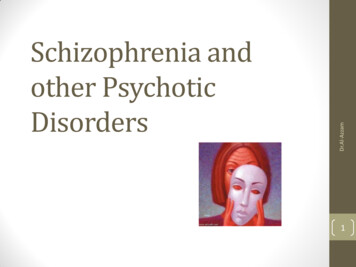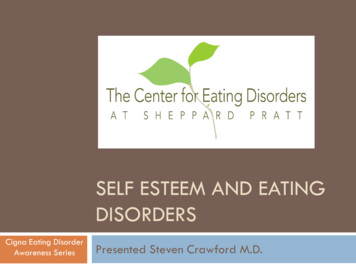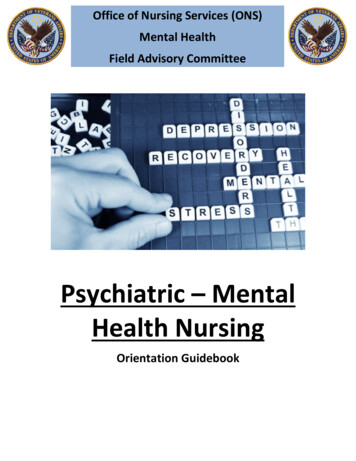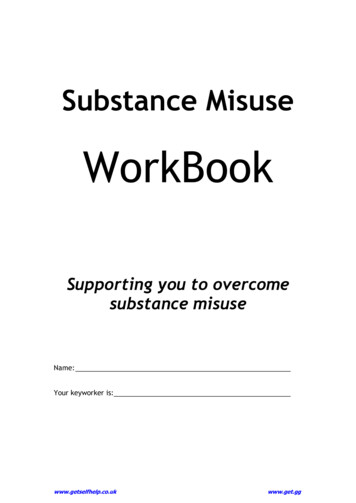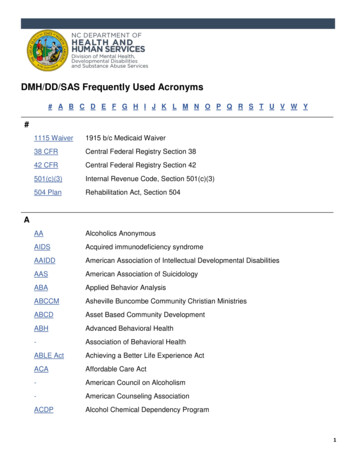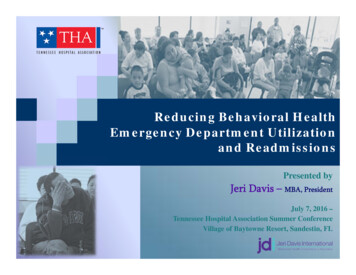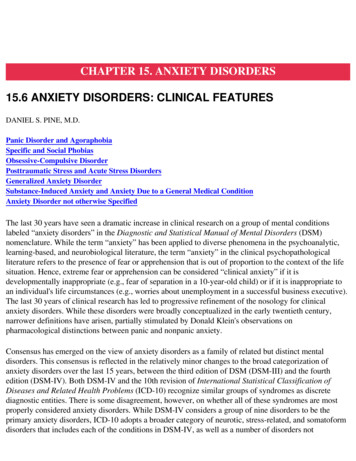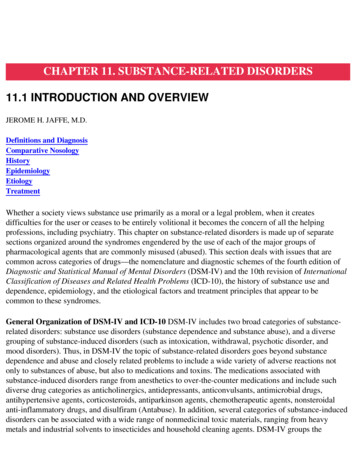
Transcription
11.1 INTRODUCTION AND OVERVIEWKaplan & Sadock’s Comprehensive Textbook of PsychiatryCHAPTER 11. SUBSTANCE-RELATED DISORDERS11.1 INTRODUCTION AND OVERVIEWJEROME H. JAFFE, M.D.Definitions and DiagnosisComparative r a society views substance use primarily as a moral or a legal problem, when it createsdifficulties for the user or ceases to be entirely volitional it becomes the concern of all the helpingprofessions, including psychiatry. This chapter on substance-related disorders is made up of separatesections organized around the syndromes engendered by the use of each of the major groups ofpharmacological agents that are commonly misused (abused). This section deals with issues that arecommon across categories of drugs—the nomenclature and diagnostic schemes of the fourth edition ofDiagnostic and Statistical Manual of Mental Disorders (DSM-IV) and the 10th revision of InternationalClassification of Diseases and Related Health Problems (ICD-10), the history of substance use anddependence, epidemiology, and the etiological factors and treatment principles that appear to becommon to these syndromes.General Organization of DSM-IV and ICD-10 DSM-IV includes two broad categories of substancerelated disorders: substance use disorders (substance dependence and substance abuse), and a diversegrouping of substance-induced disorders (such as intoxication, withdrawal, psychotic disorder, andmood disorders). Thus, in DSM-IV the topic of substance-related disorders goes beyond substancedependence and abuse and closely related problems to include a wide variety of adverse reactions notonly to substances of abuse, but also to medications and toxins. The medications associated withsubstance-induced disorders range from anesthetics to over-the-counter medications and include suchdiverse drug categories as anticholinergics, antidepressants, anticonvulsants, antimicrobial drugs,antihypertensive agents, corticosteroids, antiparkinson agents, chemotherapeutic agents, nonsteroidalanti-inflammatory drugs, and disulfiram (Antabuse). In addition, several categories of substance-induceddisorders can be associated with a wide range of nonmedicinal toxic materials, ranging from heavymetals and industrial solvents to insecticides and household cleaning agents. DSM-IV groups the
diagnostic criteria for substance dependence, abuse, intoxication, hallucinogen persisting perceptiondisorder, and withdrawal syndromes in a section titled “Substance-Related Disorders,” whereas the othersubstance-related disorders (e.g., substance-induced mood disorders and substance-induced delusionaldisorders) are described in the sections covering the disorders that they most closely resemblephenomenologically (Table 11.1-1).Table 11.1-1 Substance-Induced Mental Disorders IncludedElsewhere in the TextbookThe DSM-IV section dealing with substance dependence and substance abuse presents descriptions ofthe clinical phenomena associated with the use of 11 designated classes of pharmacological agents:alcohol, amphetamines or similarly acting agents; caffeine; cannabis; cocaine; hallucinogens; inhalants;nicotine; opioids; phencyclidine (PCP) or similar agents; and sedatives, hypnotics, and anxiolytics. Aresidual twelfth category includes a variety of agents, such as anabolic steroids and nitrous oxide, thatare not in the 11 designated classes.ICD-10 considers the disorders due to psychoactive substance use within the confines of analphanumeric system that allows only nine categories of pharmacological agents, with one residualcategory to cover both multiple drug use and use of psychoactive substances not included in the ninedesignated categories. DSM-IV and ICD-10 categorize substances comparably, with the followingexceptions. Caffeine and PCP are considered distinct categories in DSM-IV; whereas in ICD-10,problems related to caffeine are included in the category of other stimulants such as amphetamine, andphencyclidine must be included with hallucinogens or in the residual category. Also, ICD-10 has aspecial category for abuse of non–dependence-producing substances (Table 11.1-2). Specificallymentioned are antidepressants, analgesics, antacids, vitamins, and steroids or hormones.Table 11.1-2 ICD-10 Diagnostic Criteria for Abuse of Non-Dependence-Producing Substances
DEFINITIONS AND DIAGNOSISSubstance Dependence The revised third edition of DSM (DSM-III-R), DSM-IV, and ICD-10formulations for substance abuse and dependence closely follow the concepts and terminologydeveloped in 1980 by an International Working Group sponsored by the World Health Organization(WHO) and the Alcohol, Drug Abuse, and Mental Health Administration (ADAMHA) of the UnitedStates, which defined substance dependence as follows:A syndrome manifested by a behavioral pattern in which the use of a given psychoactivedrug, or class of drugs, is given a much higher priority than other behaviors that once hadhigher value. The term “syndrome” is taken to mean no more than a clustering ofphenomena so that not all the components need always be present or not always presentwith the same intensity. . . . The dependence syndrome is not absolute, but is aquantitative phenomenon that exists in different degrees. The intensity of the syndrome ismeasured by the behaviors that are elicited in relation to using the drug and by the otherbehaviors that are secondary to drug use. . . . No sharp cut-off point can be identified fordistinguishing drug dependence from non-dependent but recurrent drug use. At theextreme, the dependence syndrome is associated with “compulsive drug-using behavior.”That central notion is continued in DSM-IV, which states:The essential feature of dependence is a cluster of cognitive, behavioral, and physiologicalsymptoms indicating that the individual continues substance use despite significantsubstance-related problems.The central notion in ICD-10 is virtually the same:a cluster of behavioural, cognitive, and physiological phenomena that develop afterrepeated substance use and typically include a strong desire to take the drug, difficulties incontrolling its use, persisting in its use despite harmful consequences, a higher prioritygiven to drug use than to other activities and obligations, increased tolerance, andsometimes a physical withdrawal state.
The DSM-IV and ICD-10 criteria for substance dependence are presented in Table 11.1-3 and Table11.1-4. DSM-IV uses seven criteria to describe a generic concept of dependence that applies across 11classes of pharmacological agents. ICD-10 requires that three of six criteria be met and also appliesacross classes of drugs.Table 11.1-3 DSM-IV Diagnostic Criteria for SubstanceDependenceTable 11.1-4 ICD-10 Diagnostic Criteria for Mental andBehavioral Disorders Due to Psychoactive Substance UseDSM-IV and ICD-10 use a polythetic syndrome definition, in which no one specific criterion is requiredso long as three or more are present. However, DSM-IV asks the clinician to specify whetherphysiological dependence (evidence of criterion 1, tolerance, or criterion 2, withdrawal) is present orabsent. Evidence indicates that physiological dependence is associated with a more severe form of thedisorder.In addition to requiring the clustering of three criteria in a 12-month period, DSM-IV includes a fewother qualifications. It states specifically that the diagnosis of dependence can be applied to every classof substances except caffeine. That point is admittedly controversial, and some researchers believe, onthe basis of the same DSM-IV generic criteria, that caffeine produces a distinct form of dependence,although it is relatively benign for most persons.Some persons use several categories of drugs and are clearly drug dependent, according to the genericcriteria, but it may not be possible to ascertain whether they are dependent on any one specific class ofdrugs. When at least three groups of substances are involved, DSM-IV calls the condition polysubstance
dependence (Table 11.1-5). DSM-IV also makes provision for classifying substance-related disordersthat cannot be classified in any of the previous categories (e.g., nitrous oxide, anticholinergics, anabolicandrogenic steroids) or for an initial diagnosis of dependence or abuse when the specific substance is notknown. A similar residual category is included in ICD-10, but steroids are given a distinct code. TheDSM-IV diagnostic criteria for other (or unknown) substance-related disorders are listed in Table 11.1-6.Table 11.1-5 DSM-IV Diagnostic Criteria for PolysubstanceDependenceTable 11.1-6 DSM-IV Diagnostic Criteria for Other (orUnknown) Substance-Related DisordersPatterns of Remission and Course Specifiers DSM-IV and ICD-10 deal with remission by providingdistinct modifying terms that can be appended to a diagnosis of substance dependence. DSM-IV termsare more varied than those of ICD-10 (Table 11.1-7). The DSM-IV course specifiers require a period ofat least 1 month, after a period of active dependence, during which no criteria of dependence are present.If a patient has not met any criteria for dependence for at least 1 month but for less than 12 months, thecourse specifier to use is early full remission. If the period during which no criteria of dependence aremet exceeds 12 months, the specifier of sustained full remission can be used. If the full criteria fordependence or abuse have not been met for less than a year, but one or more criteria have been present,early partial remission may be used. If the period exceeds 12 months, sustained partial remission may beused. Two additional remission specifiers should be used when appropriate: “on agonist therapy(includes partial agonists)” and “in a controlled environment.” Several factors, such as duration ofremission and duration of period of dependence, must be considered in deciding that a person has fullyrecovered and no longer warrants a diagnosis of dependence. The modifiers that describe the course ofdependence in ICD-10 are similar, but specific criteria for selecting them are not provided.
Table 11.1-7 DSM-IV Course Modifiers for SubstanceDependenceSubstance Abuse DSM-IV defines the essential features of substance abuse as follows:A maladaptive pattern of substance use manifested by recurrent and significant adverseconsequences related to the repeated use of substances. . . . These problems must occurrecurrently during the same 12-month period. . . . [T]he criteria for Substance Abuse donot include tolerance, withdrawal, or a pattern of compulsive use and instead include onlythe harmful consequences of repeated use. A diagnosis of Substance Abuse is preemptedby the diagnosis of Substance Dependence if the individual's pattern of substance use hasever met the criteria for Dependence for that class of substances.The DSM-IV criteria for substance abuse are shown in Table 11.1-8.Table 11.1-8 DSM-IV Diagnostic Criteria for Substance AbuseA major difference exists between DSM-IV and ICD-10 with regard to the diagnosis of substance abuse.ICD-10 does not use the term “abuse.” Instead, it includes a category of harmful use, which substantiallydiffers from the DSM-IV concept of “abuse.” The concept of “harmful use” is limited to mental andphysical health (e.g., hepatitis and overdose, or episodes of depressive disorder resulting from heavyalcohol use). The concept specifically excludes social impairment, stating: “The fact that a pattern of useof a particular substance is disapproved of. or may have led to socially negative consequences such asarrest or marital arguments is not in itself evidence of harmful use.” Four diagnostic criteria must be metto make the ICD-10 diagnosis of harmful use.
Substance Withdrawal Substance withdrawal, as used in DSM-IV, is a diagnostic term rather than atechnical term. Thus minor symptoms that technically are due to cessation of substance use (e.g., thecoffee drinker's early morning precoffee lethargy or minor headache) would not by themselves fulfill thecriteria for substance withdrawal, unless they are accompanied by a maladaptive behavior change andcause some clinically significant distress or impairment in social, occupational, or other important areaof functioning. DSM-IV does not recognize withdrawal from caffeine, cannabis, or PCP, although someobservers believe that specific signs and symptoms can be observed when those agents are abruptlydiscontinued after a period of heavy use. ICD-10 does describe a cannabinoid withdrawal state.Withdrawal is commonly, but not invariably, associated with substance dependence. The signs andsymptoms of withdrawal vary with the specific class of drug. In general, the severity of withdrawal isrelated to the amount of substance used and the duration and patterns of use. Withdrawal is seen not onlywhen substance use is stopped but also when reduced use of a substance or a change in metabolismresults in lower tissue levels. The DSM-IV generic criteria for substance withdrawal are shown in Table11.1-9; the ICD-10 general criteria are shown in Table 11.1-4. Specific diagnostic criteria for withdrawalfrom each category of drugs, to be used when the general criteria have been met, are also provided.Table 11.1-9 DSM-IV Diagnostic Criteria for SubstanceWithdrawalSubstance Intoxication Substance intoxication is defined more narrowly in DSM-IV than it might be ina pharmacology text. A variety of substances may produce unwanted physiological or psychologicaleffects that could be construed as substance intoxication effects (e.g., excessive sleepiness following useof an antihistamine), but unless the symptoms are associated with maladaptive behavior, the effectswould not constitute substance-induced intoxication as defined in DSM-IV. Furthermore, whether abehavioral effect is maladaptive depends on the social and environmental context in which it occurs. Ifalcohol makes a person unusually sociable, a bit garrulous, and a little uncoordinated at a familycelebration this is probably not maladaptive drinking behavior, the same behavior at a formal businessmeeting probably is. Similarly, ICD-10 specifies that intoxication must produce disturbances in the levelof consciousness, cognition, perception, affect, or behavior that are of clinical importance. However, itrequests clinicians to further specify which of several common complications of intoxication (e.g.,trauma, delirium, convulsions) are also present. The DSM-IV general criteria for substance intoxicationare shown in Table 11.1-10. In addition, ICD-10 provides specific sets of diagnostic criteria for each ofthe drug categories and for multiple drugs, to be used once the generic criteria for intoxication have been
met. Also shown are the additional specifiers for complications of intoxication (Table 11.1-4).Table 11.1-10 DSM-IV Diagnostic Criteria for SubstanceIntoxicationSubstance-Induced Disorders In addition to dependence, abuse, intoxication, and withdrawal, the useof certain psychoactive drugs can induce syndromes that used to be called organic mental disorders. Toavoid implying that other psychiatric disorders do not have an organic basis, DSM-IV designates thesesyndromes substance-induced disorders and recognizes the following categories: substance intoxication,substance withdrawal, substance-induced withdrawal delirium, substance-induced intoxication delirium,substance-induced persisting dementia, substance-induced persisting amnestic disorder, substanceinduced mood disorder, substance-induced anxiety disorder, substance-induced psychotic disorder,substance-induced sexual dysfunction, and substance-induced sleep disorder.In recording a diagnosis of a substance-related disorder, the clinician should indicate the specific agentcausing the disorder, if known, rather than the broad drug category; that is, substance-inducedintoxication, pentobarbital (Nembutal) rather than substance-induced intoxication, sedative-hypnotics.However, the diagnostic code should be selected from the list of classes of substances provided in sets ofcriteria for the substance-induced disorder being recorded. For each of the substance-induced disorders(other than intoxication and withdrawal), the clinician is asked to specify whether the onset was duringintoxication or during withdrawal. Thus, a specific substance-induced disorder would have a three-partname delineating (1) the specific substance, (2) the context (whether the disorder occurred duringintoxication or during withdrawal or occurs or persists beyond those stages), and (3) thephenomenological presentation (e.g., diazepam [Valium]-induced anxiety disorder with onset duringwithdrawal).Table 11.1-11 shows the various disorders induced by the major categories of substances recognized byDSM-IV and indicates which disorders are seen during intoxication and during withdrawal. Althoughthey are not included specifically in the table, anabolic-adrenergic steroids can also induce psychoticmood, anxiety, and sleep and sexual disorders, and their withdrawal can also be associated with moodand sleep disorders. ICD-10 has a distinctly different approach to recording these drug-related disorders.With the first and second digits after the letter committed to designating the drug category, additionalpsychiatric syndromes are indicated by the use of the third and fourth digits. For example, persistentmood disorder associated with hallucinogens is designated F16.72. For the diagnosis to be made, themood disorder would need to meet the criteria listed for mood (affective) disorders.
Table 11.1-11 DSM-IV Diagnoses Associated With Class ofSubstancesEvolving Terminology The terminology used to describe the substance-related disorders has beenrepeatedly revised as concepts about the nature of drug-using behavior have evolved. In the 1980 thirdedition of the DSM (DSM-III) drug use disorders were divided into two major categories, drug abuseand drug dependence, and specific criteria for diagnosis were given. In DSM-III-R, adopted in 1987, thetwo categories were retained, but the diagnostic criteria were modified. Further revisions were made forDSM-IV, which adopted the terms “substance abuse” and “substance dependence,” probably toeliminate the use of the more cumbersome term “alcohol and drug dependence including tobacco.” Forsimilar reasons, ICD-10 adopted the term “psychoactive substance dependence.”In much of the world literature on drug dependence, the term “dependence” is used to convey twodistinct ideas: (1) a behavioral syndrome and (2) physical or physiological dependence. Physiologicaldependence can be defined as an alteration in neural systems that is manifested by tolerance and theappearance of withdrawal phenomena when a chronically administered drug is discontinued or displacedfrom its receptor. Because the dual use of the word causes confusion, the 1980 ADAMHA-WHOworking group recommended restricting use of the term “dependence” to describe the behavioralsyndrome and substituting the term “neuroadaptation” for physical dependence. Such a substitutionwould have emphasized several points. First, the continued use of many drugs, including tricyclicantidepressants and β-adrenergic receptor antagonists, causes neuroadaptive changes followed bywithdrawal phenomena, but not by drug-seeking behavior, on their discontinuation. Second,neuroadaptive changes begin with the first dose of an opioid or sedative drug, and therefore, suchchanges in and of themselves are not a sufficient cause (or definition) of drug dependence as abehavioral syndrome.Why Use “Addiction”? The words “addict” and “addiction” often have pejorative connotations; theyare also frequently trivialized and used to refer to ordinary activities, such as exercising and solvingcrossword puzzles. However, the term “addiction” continues to have the core connotation of decreasedcontrol, and some chapters in this book have retained such terms as “opioid addict” because they are lessawkward to use than terms such as “severely opioid-dependent person” when referring to persons whoare dependent on drugs to a severe degree. Here the word “dependent,” unmodified, is used to meanbehaviorally dependent. The term “physiological dependence” or “physical dependence” is used to referto the physiological changes that result in withdrawal symptoms when drugs are discontinued.
COMPARATIVE NOSOLOGYDSM-IV and ICD-10 The generic concept of dependence is virtually identical in DSM-IV and ICD-10.By requiring the clinician to specify whether tolerance and withdrawal are present, DSM-IV appears torecognize a special significance for tolerance and physiological dependence. Some data indicate thatamong alcoholics the presence of physical dependence and, to a lesser degree, tolerance is associatedwith a more severe variety of the syndrome. In practice, however, requiring evidence of these criteriawould not substantially reduce the number of cases meeting the criteria for dependence in most drugcategories, with the exception of hallucinogens, a class of drugs for which DSM-IV does not listphysiological dependence as a criterion. There is generally a high level of agreement between DSM-IVand ICD-10 for making a diagnosis of dependence, although the descriptions of the criteria fordetermining the presence and severity of the syndrome differ. They both require that three elements ofthe syndrome have been present in a 12-month period. The DSM-IV categorization of drug classesdiffers somewhat from the one used by ICD-10, which, constrained by a new alphanumeric system, usesonly nine drug categories by including caffeine with amphetamine-like stimulants and PCP with otherpsychoactive agents.The word “abuse” is also commonly used in ways that differ significantly from the definitions developedfor use in DSM-IV. In popular and legislative contexts drug abuse means any use of an illicit substanceor any nonprescribed use of a drug intended as a medicine, as well as the harmful or excessive use oflegally available substances, such as alcohol and tobacco.Despite the reliability of DSM-IV and ICD-10 criteria for dependence in many European and AngloAmerican cultures, several criteria (e.g., narrowing of drinking repertoire, time spent obtaining the drug,and even tolerance for the drug) have posed difficulties in other cultures, especially when dealing withalcohol. Tolerance is often understood when applied to drugs, but not to alcohol; in some cultures,holding one's liquor is a sign of manhood. Clinicians are more likely to make a diagnosis of drugdependence than alcohol dependence even when behavioral signs are comparable. In several cultures,little or no distinction is recognized between use, abuse, and harmful use of illicit drugs.Other Perspectives The criteria for diagnosis in DSM-IV and ICD-10 were developed from what isessentially a biopsychosocial model of substance dependence. In such a model multiple factors—genetic, psychological, sociological, and pharmacological—contribute to the observed clinicalsyndromes. Such apparent unanimity about drug dependence should not obscure the existence ofdissenting perspectives, which take several forms. In one the biopsychosocial model is accused of givingtoo much weight to biological factors and too little recognition to the notion of human will andresponsibility, of medicalizing deviant behavior for the benefit of treatment professionals, and ofcreating universal exculpation for all those who fail to live up to reasonable societal expectations. Butsome professionals have implicitly criticized the same biopsychosocial model for not giving sufficientweight to the ideas that substance dependence is a specific primary disease (i.e., not a symptom of otherpsychiatric difficulties), that those who develop the disease have no control over their intake of certain
substances, and that denial of the presence of a problem is a major characteristic of the disease.Concepts about substance dependence can be arrayed along several dimensions that are not entirelyindependent or orthogonal: broad versus narrow, disease versus learned behavior, and social versusmedical. The narrow concept of substance dependence accepts as disorders those maladaptive behaviorsassociated primarily, if not exclusively, with the ingestion of substances generally accepted aspharmacological agents. Compulsive eating, gambling, running, hair pulling, and repetitive excessivesexual activities are not included among the dependence disorders, although those problems may sharecertain features that resemble a decreased ability to choose and are sometimes ameliorated byparticipation in support groups founded on principles similar to those of Alcoholics Anonymous (AA).A broad approach would create a superclass of disorders that would include a number of such behaviorsnot involving pharmacological agents.At the disease end of the disease-versus-behavioral syndrome dimension is a belief that dependence isnot a learned behavior that can be modified or ameliorated with relearning but is a primary disordercaused by an interaction between a substance and a person with some genetic vulnerability and that onlytotal abstinence can arrest the progression of the disease. The medical-versus-social dimension typicallydescribes a range of views on how best to respond to problems with substances, rather than differencesabout the essential nature of the problems. The medical model stresses issues of assessment—treatment,planning, and record keeping—and sometimes treatment that can be rendered only by those withprofessional training (not necessarily physicians). The social model emphasizes the importance of socialsupports and integrating the person with a problem into a network of recovering persons who can offercontinuing support. The assessment and recording of progress and outcome as generally practiced bycredentialed professionals is minimized.HISTORYThe most commonly abused drugs have been in use for hundreds, if not thousands, of years. Forexample, opium has been used for medicinal purposes for at least 3500 years, references to cannabis(marijuana) as medicinal can be found in ancient Chinese herbals, and wine is mentioned frequently inthe Bible. The indigenous people of the Western Hemisphere were smoking tobacco and chewing cocaleaves generations before the arrival of the Spaniards. Some of the problems caused by alcohol and otherdrugs, such as drunkenness, are described in the Bible and in the writings of the ancient Greeks andRomans. As new and more concentrated forms of drugs were discovered or invented or new routes ofadministering them were developed, new problems related to their use emerged. For instance, whencheap gin was introduced into England in the eighteenth century, the alcohol-related problems thatemerged were considered more serious than those associated with beer and wine. Although opiumsmoking was a major problem in Asia in the eighteenth and nineteenth centuries, new problems wereseen after morphine, the most active opium alkaloid, was isolated in 1806. Morphine was subject tomisuse by injection from the late nineteenth century on, and intravenous morphine and heroin use beganto spread in the early part of the twentieth century. Tobacco use and its associated problems did notbecome widespread until the nineteenth century, when new methods of curing the leaves produced a
mild smoking tobacco and cigarettes were introduced, which made common the practice of inhalingtobacco smoke deeply into the lungs. By the early twentieth century, cigarette smoking was a popularpractice.Medicalizing Excessive Drug Use In 1810 Benjamin Rush, who is often credited as the first Americanphysician to suggest that excessive use of alcohol was a disease rather than exclusively a moral defect,proposed the establishment of a sober house; in 1835 Samuel Woodward, a pioneer in the establishmentof asylums for the insane, advocated similar asylums for inebriates. Contemporaneous with those earlymoves to involve medicine in dealing with excessive alcohol use was the emergence of the temperancemovement and the Washingtonians—groups of reformed drunkards concerned with helping others toadopt and maintain sobriety. In the process the Washingtonians developed many of the principles of selfhelp that were rediscovered by AA almost a century later. When the ideas of voluntarism and self-helpas exemplified by Washingtonian societies failed to eliminate the problem of drunkenness, physiciansbegan to debate more seriously the idea of coerced treatment in inebriate asylums supported by publicfunds. In 1870 advocates of the approach established the American Association for the Cure ofInebriates (AACI), dedicated to setting up hospitals for such persons, conducting research, and teachingmedical students and physicians how to treat inebriety. At first those physicians who believed in a morespiritual, voluntary approach to the problem (neo-Washingtonians) were part of the AACI, but graduallythe more somatically oriented factions, which advocated medically supervised asylums (and compulsorytreatment when needed), gained ascendancy. Furthermore, the focus of concern was no longer limited tothose who abused alcohol. Thomas Crothers, the secretary of AACI, saw inebriate asylums as places totreat all those who used any variety of intoxicant or narcotic to excess. However, very few publiclysupported inebriate asylums ever opened.Early Attitudes The closing years of the nineteenth century saw growing concern about the excessiveand inappropriate use of drugs, including alcohol and tobacco as well as opiates and cocaine. Firstisolated from the coca leaf in 1860, cocaine came into widespread use in 1885 when pharmaceuticalcompanies began selling it in the United States and Europe. In 1884 Sigmund Freud had published areview of the potential therapeutic uses of cocaine. Some medical authorities in the United States sharedhis enthusiasm, and cocaine was recommended
arrest or marital arguments is not in itself evidence of harmful use.” Four diagnostic criteria must be met to make the ICD-10 diagnosis of harmful use. Substance Withdrawal Substance withdrawal, as used in DSM-IV, is a diagnostic term rather than a technical term. Thus minor symptoms that


